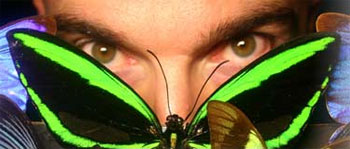Nature’s engineering shows butterfly innovation
University of Exeter news release
November 18, 2005
Editor’s summary: Flourescent patches on the wings of African swallowtail butterflies work in a very similar, but more efficient way to high emission light emitting diodes (LEDs) used in electronic equipment and displays, according to University of Exeter research published in Science.
Butterflies have evolved a unique mechanism to create a dazzling display of colour which puts physicists in the shade. Modern light emitting devices have traditionally been inefficient because most of the light created can’t escape, but now in a paper published in Science, University of Exeter scientists have discovered the butterfly has been doing what physics couldn’t, for more than 30 million years.
In order for LEDs (light emitting diodes) to function efficiently physicists have spent years analysing their design to come up with features which help to maximise the amount of light released. These include a specialised mirror to reflect light and micro holes which stop light from being trapped inside the device or from spreading sideways.
But it seems anything we can do nature can do better. When Dr Pete Vukusic studied African Swallowtail butterflies he found the creatures had evolved to include exactly these adaptations. This butterfly emits blue-green light, which it uses for signalling, using a fluorescent pigment on its wings.
 Pete Vukusic |
Dr Pete Vukusic, of the School of Physics said: “It’s amazing that butterflies have evolved such sophisticated design features which can so exquisitely manipulate light and colour. Nature’s design and engineering is truly inspirational. Pigment on the butterflies’ wings absorbs ultra-violet light which is then re-emitted, using fluorescence, as brilliant blue-green light. This adds to the colour intensity of the wing. Much of this light would be lost, resulting in a much duller effect, but the pigment is located in a region of the wing which has evenly spaced micro-holes through it.”
He continues: “The function of the micro-scales is identical to those in the LED; they prevent the fluorescent colour from being trapped inside the structure and from being emitted sideways. The scales on the wing also have a specialised mirror underneath them, again very similar in design to that in the LED. This mirror upwardly reflects all the fluorescent light that gets emitted down towards it. The result is a very efficient system for fluorescent emission that gives the butterfly significant control of the direction in which the light is emitted.”
-
Releated articles
Biomimetics, technology that mimics nature (11-July-2005)
Engineers, scientists, and business people are increasingly turning toward nature for design inspiration. The field of biomimetics, the application of methods and systems, found in nature, to engineering and technology, has spawned a number of innovations far superior to what the human mind alone could have devised. The reason is simple. Nature, through billions of years of trial and error, has produced effective solutions to innumerable complex real-world problems. The rigorous competition of natural selection means waste and efficiency are not tolerated in natural systems, unlike many of the technologies devised by humans.
Biomimicry Employed by MIT Nanotechnology Researchers (September 21, 2005) The ocean is a perilous environment for a soft-bodied creature like a sea snail, so nature gives it an advanced nanostructured armor system that is stiff and strong yet lightweight. It’s called a shell. Understanding the fundamental design principles of natural armor systems like shells may help engineers design improved body armor systems for humans in perilous situations, like soldiers and police officers. At MIT’s Institute for Soldier Nanotechnologies, researchers are studying the structure and mechanics of the tough inner layer of mollusc shells, called “nacre” or mother-of-pearl, at extremely small, nanometer-length scales (a nanometer is a billionth of a meter).
Design of new Mercedes-Benz bionic car inspired by fish body shape (10-July-2005) DaimlerChrysler is using a new concept vehicle to examine the great potential of bionics for automobile development, and has achieved outstanding results for fuel consumption and emissions with a combination of pioneering diesel engine technology and innovative emission control methods. The Mercedes-Benz bionic car study will have its world premiere at this year’s DaimlerChrysler Innovation Symposium in Washington.
Nature Provides Design Template for Human Problems (November 1, 2005)
Copying the ideas of others is usually frowned upon, but when it comes to the work of Mother Nature, scientists are finding they can use nature as a template. An interdisciplinary group of scientists and engineers at the Georgia Institute of Technology recently formed the Center for Biologically Inspired Design (CBID) with the goal of capitalizing on the rich source of design solutions present in biological processes. The researchers believe nature can inspire design and engineering solutions that are efficient, practical and sustainable and thus have the potential to greatly enhance new technologies, materials and processes.
This is a modified news release from The University of Exeter. This original appears at 30 million years ahead – how the butterfly beat technology to it.